Page 73 of 106
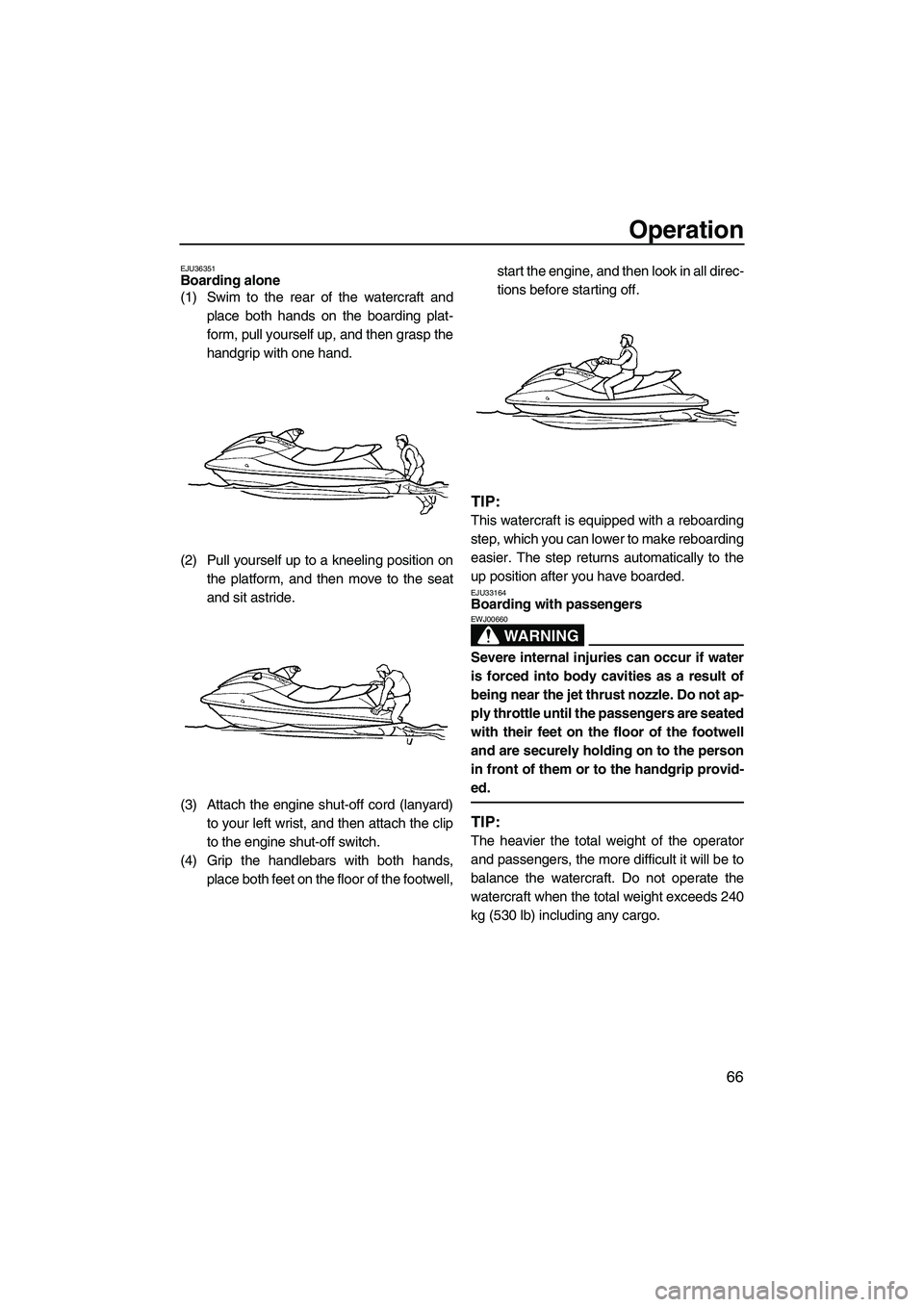
Operation
66
EJU36351Boarding alone
(1) Swim to the rear of the watercraft and
place both hands on the boarding plat-
form, pull yourself up, and then grasp the
handgrip with one hand.
(2) Pull yourself up to a kneeling position on
the platform, and then move to the seat
and sit astride.
(3) Attach the engine shut-off cord (lanyard)
to your left wrist, and then attach the clip
to the engine shut-off switch.
(4) Grip the handlebars with both hands,
place both feet on the floor of the footwell,start the engine, and then look in all direc-
tions before starting off.
TIP:
This watercraft is equipped with a reboarding
step, which you can lower to make reboarding
easier. The step returns automatically to the
up position after you have boarded.
EJU33164Boarding with passengers
WARNING
EWJ00660
Severe internal injuries can occur if water
is forced into body cavities as a result of
being near the jet thrust nozzle. Do not ap-
ply throttle until the passengers are seated
with their feet on the floor of the footwell
and are securely holding on to the person
in front of them or to the handgrip provid-
ed.
TIP:
The heavier the total weight of the operator
and passengers, the more difficult it will be to
balance the watercraft. Do not operate the
watercraft when the total weight exceeds 240
kg (530 lb) including any cargo.
UF2H70E0.book Page 66 Thursday, January 15, 2009 10:49 AM
Page 74 of 106
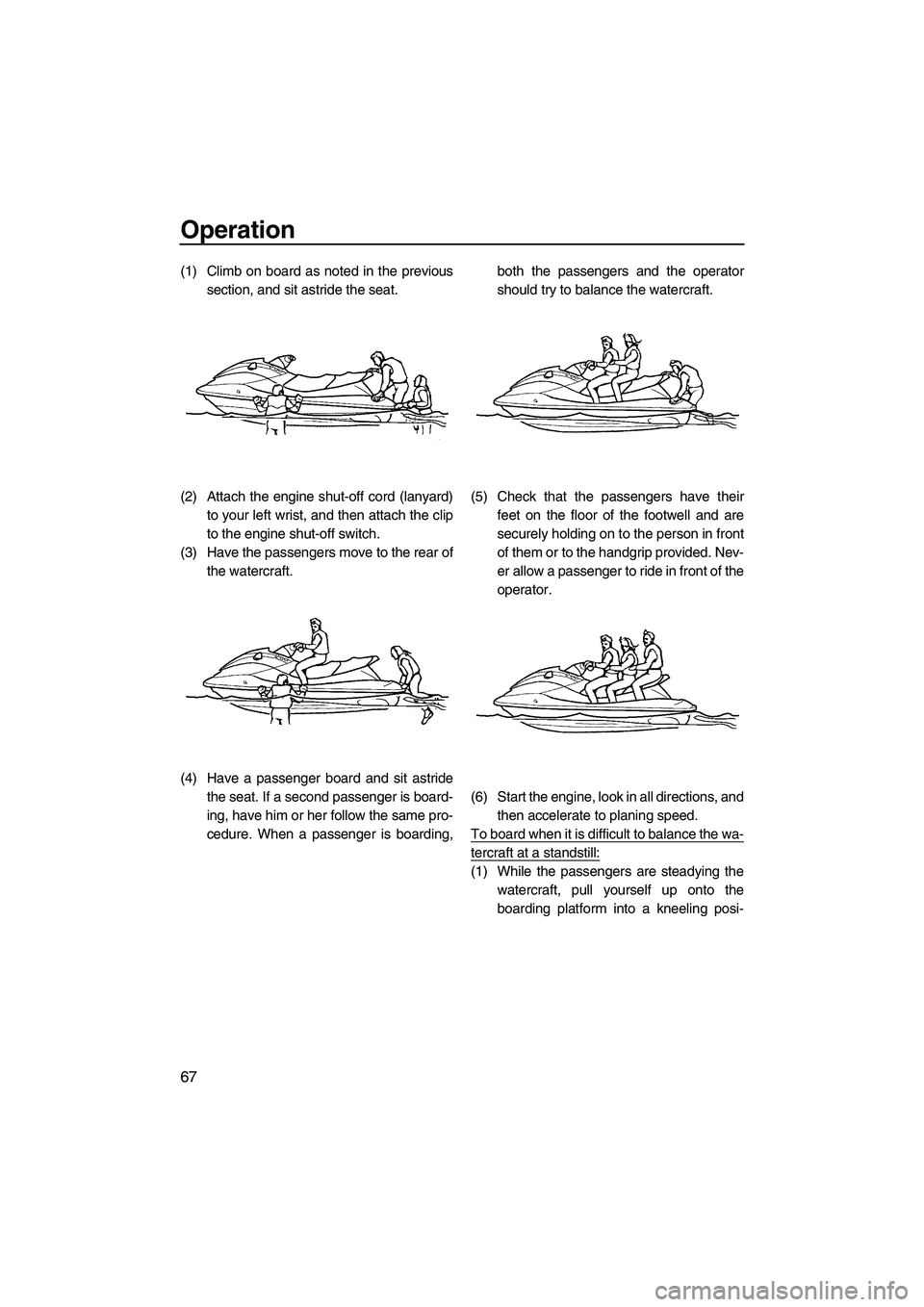
Operation
67
(1) Climb on board as noted in the previous
section, and sit astride the seat.
(2) Attach the engine shut-off cord (lanyard)
to your left wrist, and then attach the clip
to the engine shut-off switch.
(3) Have the passengers move to the rear of
the watercraft.
(4) Have a passenger board and sit astride
the seat. If a second passenger is board-
ing, have him or her follow the same pro-
cedure. When a passenger is boarding,both the passengers and the operator
should try to balance the watercraft.
(5) Check that the passengers have their
feet on the floor of the footwell and are
securely holding on to the person in front
of them or to the handgrip provided. Nev-
er allow a passenger to ride in front of the
operator.
(6) Start the engine, look in all directions, and
then accelerate to planing speed.
To board when it is difficult to balance the wa-
tercraft at a standstill:
(1) While the passengers are steadying the
watercraft, pull yourself up onto the
boarding platform into a kneeling posi-
UF2H70E0.book Page 67 Thursday, January 15, 2009 10:49 AM
Page 75 of 106

Operation
68
tion, and then move to the seat and sit
astride to balance the watercraft.
(2) Have a passenger pull him or herself up
onto the boarding platform into a kneeling
position, then move to the seat and sit
astride to balance the watercraft.
(3) Attach the engine shut-off cord (lanyard)
to your left wrist, and then attach the clip
to the engine shut-off switch.
(4) Start the engine and keep it at idle.
(5) Have the second passenger pull him or
herself up onto the boarding platform into
a kneeling position, then crawl onto the
seat as the watercraft accelerates.(6) Gradually increase the speed to balance
the watercraft.
EJU33231Capsized watercraft
WARNING
EWJ00671
Improper uprighting can cause injury.
�Be sure to shut the engine off by pulling
on the engine shut-off cord (lanyard) to
remove the clip from the engine shut-off
switch.
�Do not put your hands in the intake
grate.
If the watercraft capsizes, turn it over immedi-
ately.
Be sure to carefully follow the procedures be-
low to prevent injury, or damage to the water-
craft.
(1) Remove the clip from the engine shut-off
switch.
(2) Swim to the rear of the watercraft. Pull the
watercraft over with your left hand on the
ride plate while pushing down on the gun-
wale with your right hand or foot.
If the port (left) side of the capsized wa-
tercraft is tilting up, push down on the
gunwale so that the port (left) side is
down before turning the watercraft clock-
wise. NOTICE: Do not turn the water-
craft over counterclockwise,
otherwise water can enter the engine,
UF2H70E0.book Page 68 Thursday, January 15, 2009 10:49 AM
Page 76 of 106
![YAMAHA FX HO CRUISER 2009 Owners Manual Operation
69
which can result in severe damage.
[ECJ00541]
(3) Start the engine and operate the water-
craft as straight as possible and above
planing speed for at least 2 minutes to
discharge any wat YAMAHA FX HO CRUISER 2009 Owners Manual Operation
69
which can result in severe damage.
[ECJ00541]
(3) Start the engine and operate the water-
craft as straight as possible and above
planing speed for at least 2 minutes to
discharge any wat](/manual-img/51/49831/w960_49831-75.png)
Operation
69
which can result in severe damage.
[ECJ00541]
(3) Start the engine and operate the water-
craft as straight as possible and above
planing speed for at least 2 minutes to
discharge any water remaining in the en-
gine compartment. (If the engine does
not start, see “Towing the watercraft” on
page 95 or “Submerged watercraft” on
page 95.) NOTICE: Do not operate the
engine at full throttle for at least 1
minute after the engine has been re-
started. Excessive water in the engine
compartment can splash into the en-
gine, which can result in severe dam-
age.
[ECJ00551]
EJU33251
Turning the watercraft
WARNING
EWJ00770
�Do not release the throttle lever when
trying to steer away from objects—youneed throttle to steer. A collision could
result in severe injury or death.
�When operating at higher speeds, make
gradual turns or slow down before turn-
ing. Sharp high-speed turns may cause
the watercraft to slide sideways or spin,
throwing the operator and passengers
overboard, which could cause an injury.
Steering control depends on the combination
of handlebar position and the amount of throt-
tle.
Water sucked in through the intake grate is
pressurized by the impeller in the jet pump. As
the pressurized water is expelled from the
pump through the jet thrust nozzle, it creates
thrust to move and steer the watercraft. The
higher the engine speed, the more thrust pro-
duced.
The amount of jet thrust, in addition to the po-
sition of the handlebars, determines how
sharply you turn.
A. More throttle produces higher thrust, so
the watercraft will turn more sharply.
UF2H70E0.book Page 69 Thursday, January 15, 2009 10:49 AM
Page 77 of 106
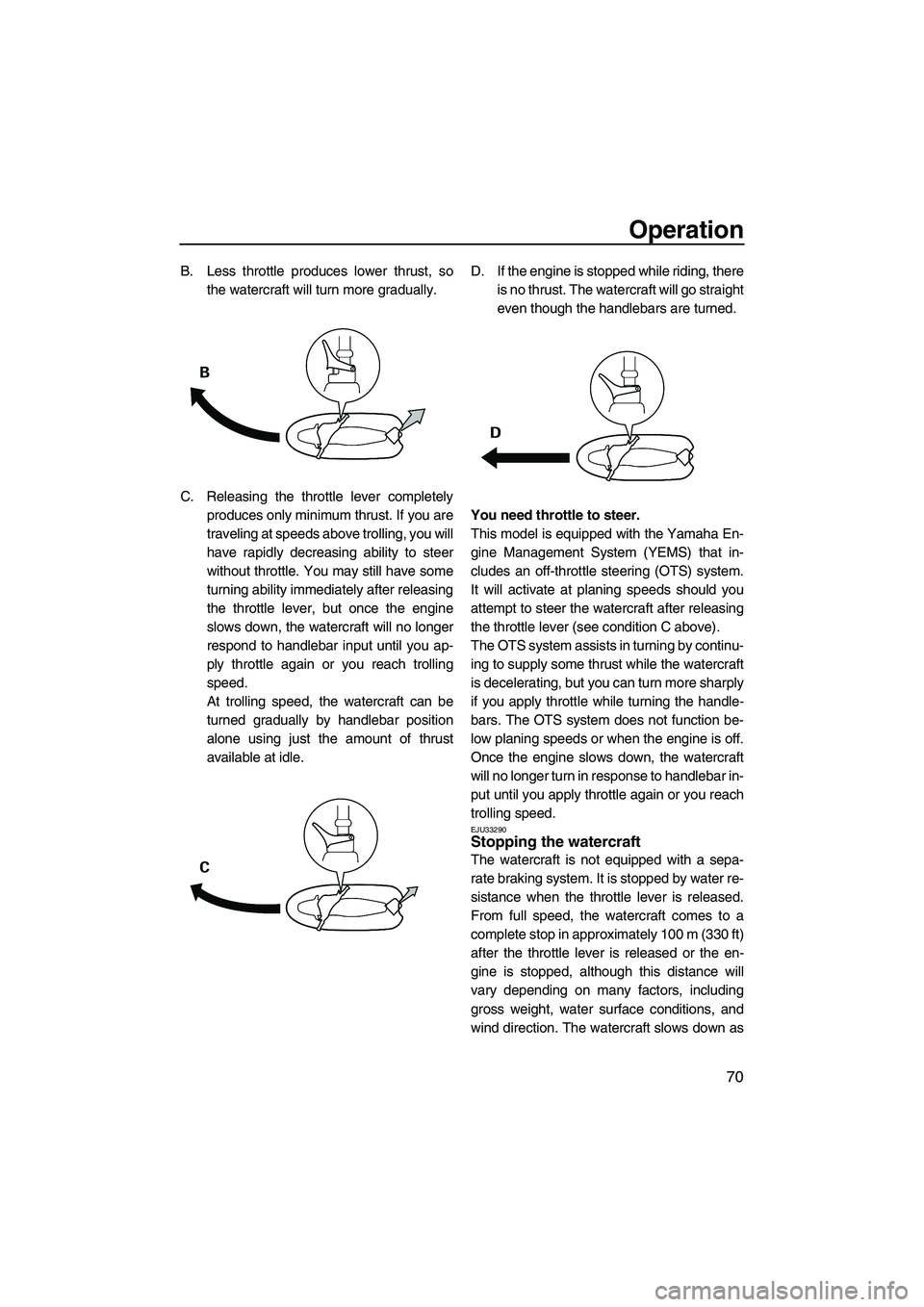
Operation
70
B. Less throttle produces lower thrust, so
the watercraft will turn more gradually.
C. Releasing the throttle lever completely
produces only minimum thrust. If you are
traveling at speeds above trolling, you will
have rapidly decreasing ability to steer
without throttle. You may still have some
turning ability immediately after releasing
the throttle lever, but once the engine
slows down, the watercraft will no longer
respond to handlebar input until you ap-
ply throttle again or you reach trolling
speed.
At trolling speed, the watercraft can be
turned gradually by handlebar position
alone using just the amount of thrust
available at idle.D. If the engine is stopped while riding, there
is no thrust. The watercraft will go straight
even though the handlebars are turned.
You need throttle to steer.
This model is equipped with the Yamaha En-
gine Management System (YEMS) that in-
cludes an off-throttle steering (OTS) system.
It will activate at planing speeds should you
attempt to steer the watercraft after releasing
the throttle lever (see condition C above).
The OTS system assists in turning by continu-
ing to supply some thrust while the watercraft
is decelerating, but you can turn more sharply
if you apply throttle while turning the handle-
bars. The OTS system does not function be-
low planing speeds or when the engine is off.
Once the engine slows down, the watercraft
will no longer turn in response to handlebar in-
put until you apply throttle again or you reach
trolling speed.
EJU33290Stopping the watercraft
The watercraft is not equipped with a sepa-
rate braking system. It is stopped by water re-
sistance when the throttle lever is released.
From full speed, the watercraft comes to a
complete stop in approximately 100 m (330 ft)
after the throttle lever is released or the en-
gine is stopped, although this distance will
vary depending on many factors, including
gross weight, water surface conditions, and
wind direction. The watercraft slows down as
UF2H70E0.book Page 70 Thursday, January 15, 2009 10:49 AM
Page 78 of 106
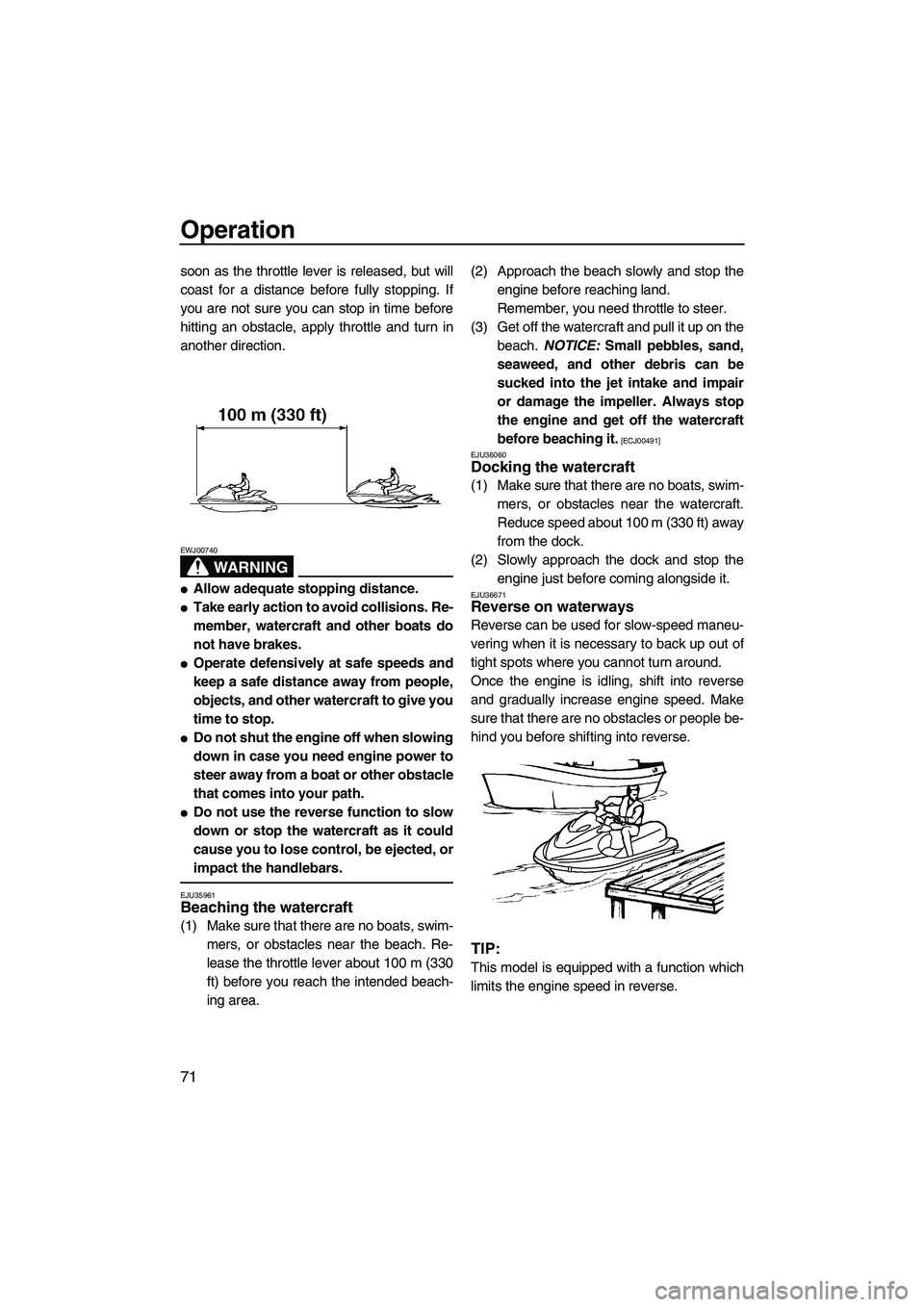
Operation
71
soon as the throttle lever is released, but will
coast for a distance before fully stopping. If
you are not sure you can stop in time before
hitting an obstacle, apply throttle and turn in
another direction.
WARNING
EWJ00740
�Allow adequate stopping distance.
�Take early action to avoid collisions. Re-
member, watercraft and other boats do
not have brakes.
�Operate defensively at safe speeds and
keep a safe distance away from people,
objects, and other watercraft to give you
time to stop.
�Do not shut the engine off when slowing
down in case you need engine power to
steer away from a boat or other obstacle
that comes into your path.
�Do not use the reverse function to slow
down or stop the watercraft as it could
cause you to lose control, be ejected, or
impact the handlebars.
EJU35961Beaching the watercraft
(1) Make sure that there are no boats, swim-
mers, or obstacles near the beach. Re-
lease the throttle lever about 100 m (330
ft) before you reach the intended beach-
ing area.(2) Approach the beach slowly and stop the
engine before reaching land.
Remember, you need throttle to steer.
(3) Get off the watercraft and pull it up on the
beach. NOTICE: Small pebbles, sand,
seaweed, and other debris can be
sucked into the jet intake and impair
or damage the impeller. Always stop
the engine and get off the watercraft
before beaching it.
[ECJ00491]
EJU36060
Docking the watercraft
(1) Make sure that there are no boats, swim-
mers, or obstacles near the watercraft.
Reduce speed about 100 m (330 ft) away
from the dock.
(2) Slowly approach the dock and stop the
engine just before coming alongside it.
EJU36671Reverse on waterways
Reverse can be used for slow-speed maneu-
vering when it is necessary to back up out of
tight spots where you cannot turn around.
Once the engine is idling, shift into reverse
and gradually increase engine speed. Make
sure that there are no obstacles or people be-
hind you before shifting into reverse.
TIP:
This model is equipped with a function which
limits the engine speed in reverse.
UF2H70E0.book Page 71 Thursday, January 15, 2009 10:49 AM
Page 79 of 106
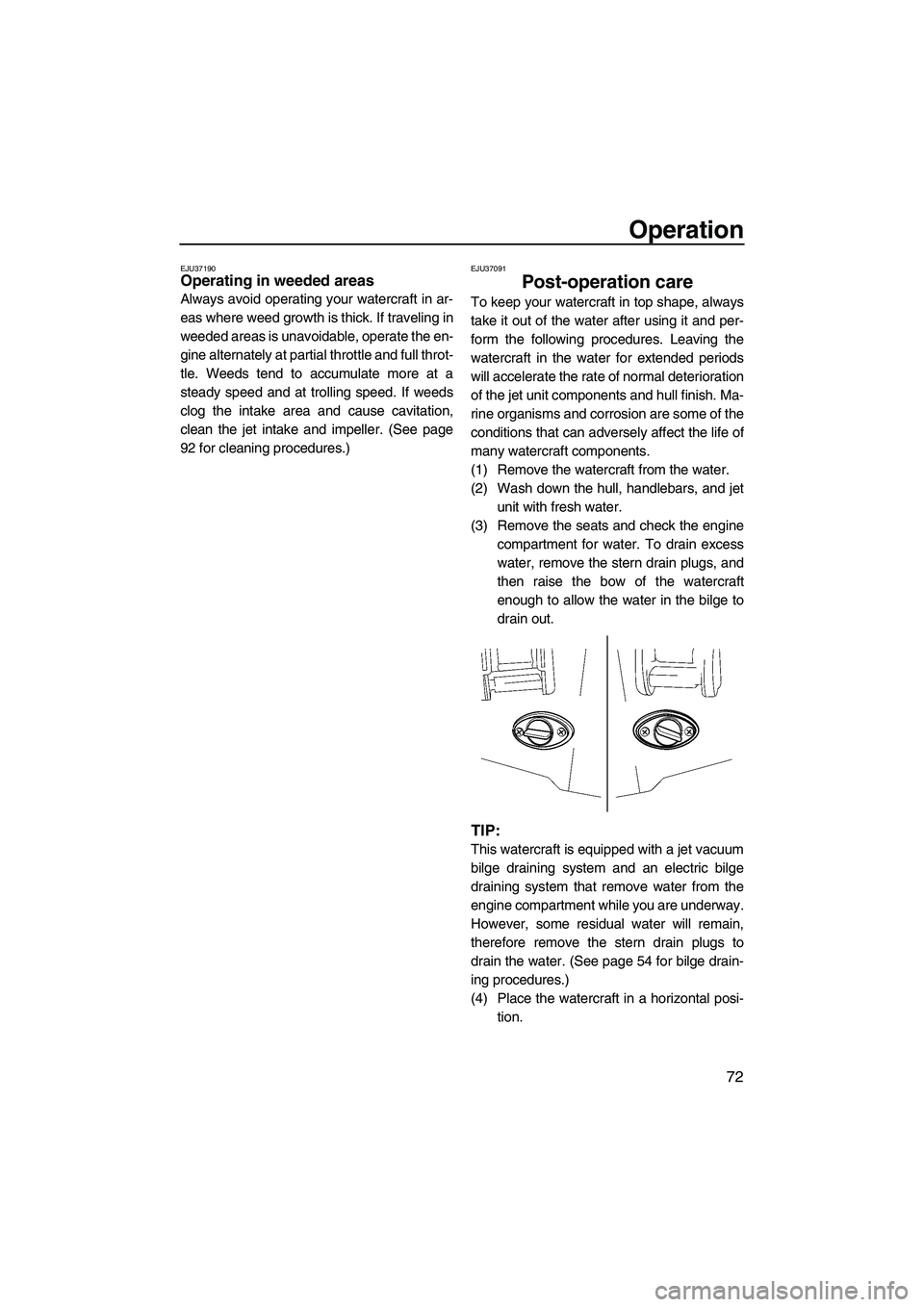
Operation
72
EJU37190Operating in weeded areas
Always avoid operating your watercraft in ar-
eas where weed growth is thick. If traveling in
weeded areas is unavoidable, operate the en-
gine alternately at partial throttle and full throt-
tle. Weeds tend to accumulate more at a
steady speed and at trolling speed. If weeds
clog the intake area and cause cavitation,
clean the jet intake and impeller. (See page
92 for cleaning procedures.)
EJU37091
Post-operation care
To keep your watercraft in top shape, always
take it out of the water after using it and per-
form the following procedures. Leaving the
watercraft in the water for extended periods
will accelerate the rate of normal deterioration
of the jet unit components and hull finish. Ma-
rine organisms and corrosion are some of the
conditions that can adversely affect the life of
many watercraft components.
(1) Remove the watercraft from the water.
(2) Wash down the hull, handlebars, and jet
unit with fresh water.
(3) Remove the seats and check the engine
compartment for water. To drain excess
water, remove the stern drain plugs, and
then raise the bow of the watercraft
enough to allow the water in the bilge to
drain out.
TIP:
This watercraft is equipped with a jet vacuum
bilge draining system and an electric bilge
draining system that remove water from the
engine compartment while you are underway.
However, some residual water will remain,
therefore remove the stern drain plugs to
drain the water. (See page 54 for bilge drain-
ing procedures.)
(4) Place the watercraft in a horizontal posi-
tion.
UF2H70E0.book Page 72 Thursday, January 15, 2009 10:49 AM
Page 80 of 106
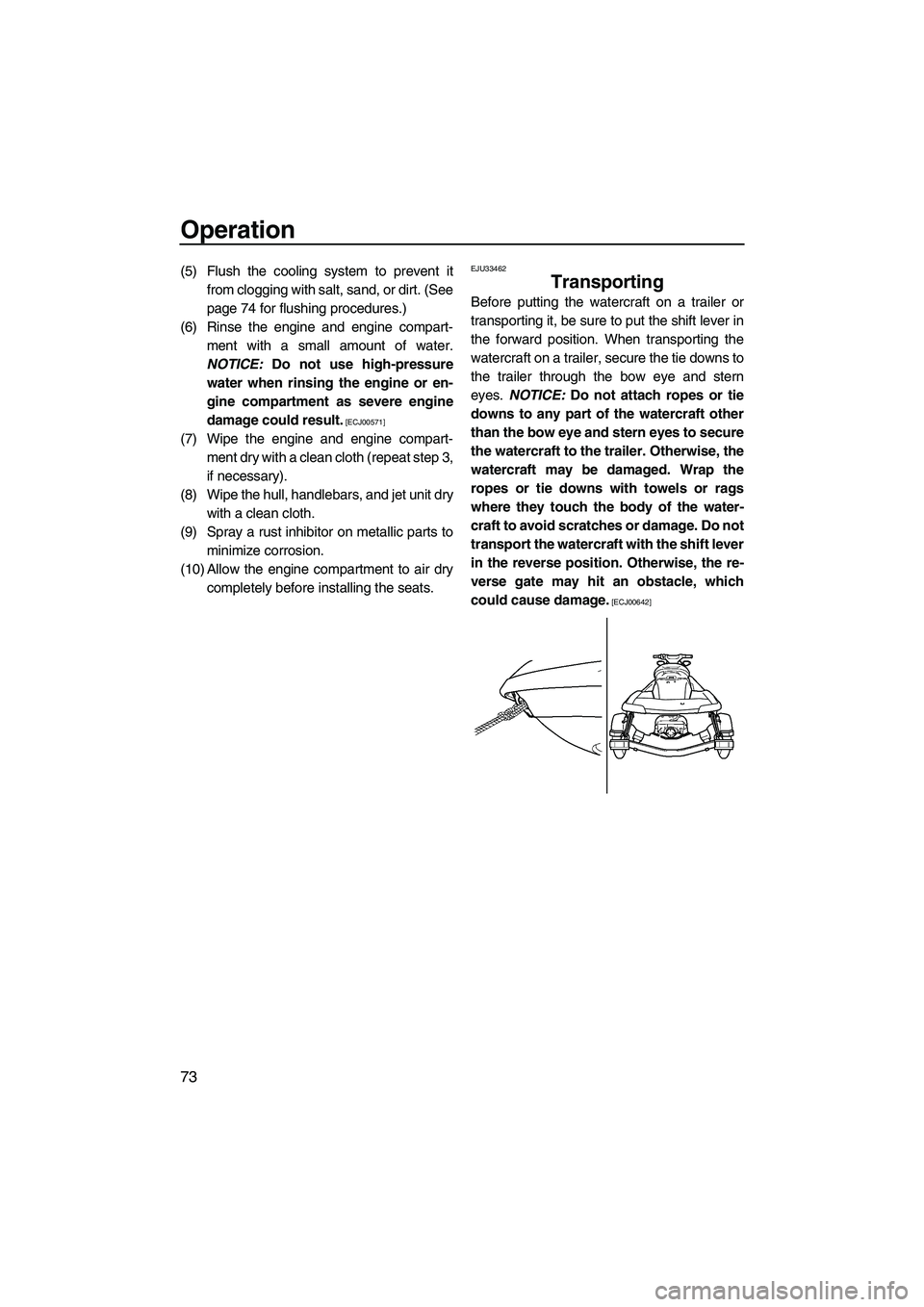
Operation
73
(5) Flush the cooling system to prevent it
from clogging with salt, sand, or dirt. (See
page 74 for flushing procedures.)
(6) Rinse the engine and engine compart-
ment with a small amount of water.
NOTICE: Do not use high-pressure
water when rinsing the engine or en-
gine compartment as severe engine
damage could result.
[ECJ00571]
(7) Wipe the engine and engine compart-
ment dry with a clean cloth (repeat step 3,
if necessary).
(8) Wipe the hull, handlebars, and jet unit dry
with a clean cloth.
(9) Spray a rust inhibitor on metallic parts to
minimize corrosion.
(10) Allow the engine compartment to air dry
completely before installing the seats.
EJU33462
Transporting
Before putting the watercraft on a trailer or
transporting it, be sure to put the shift lever in
the forward position. When transporting the
watercraft on a trailer, secure the tie downs to
the trailer through the bow eye and stern
eyes. NOTICE: Do not attach ropes or tie
downs to any part of the watercraft other
than the bow eye and stern eyes to secure
the watercraft to the trailer. Otherwise, the
watercraft may be damaged. Wrap the
ropes or tie downs with towels or rags
where they touch the body of the water-
craft to avoid scratches or damage. Do not
transport the watercraft with the shift lever
in the reverse position. Otherwise, the re-
verse gate may hit an obstacle, which
could cause damage.
[ECJ00642]
UF2H70E0.book Page 73 Thursday, January 15, 2009 10:49 AM
 1
1 2
2 3
3 4
4 5
5 6
6 7
7 8
8 9
9 10
10 11
11 12
12 13
13 14
14 15
15 16
16 17
17 18
18 19
19 20
20 21
21 22
22 23
23 24
24 25
25 26
26 27
27 28
28 29
29 30
30 31
31 32
32 33
33 34
34 35
35 36
36 37
37 38
38 39
39 40
40 41
41 42
42 43
43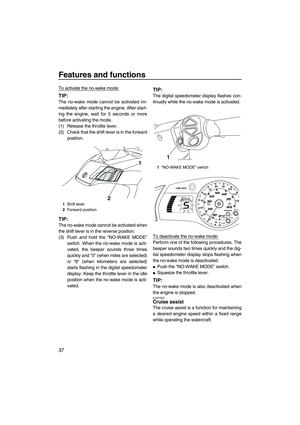 44
44 45
45 46
46 47
47 48
48 49
49 50
50 51
51 52
52 53
53 54
54 55
55 56
56 57
57 58
58 59
59 60
60 61
61 62
62 63
63 64
64 65
65 66
66 67
67 68
68 69
69 70
70 71
71 72
72 73
73 74
74 75
75 76
76 77
77 78
78 79
79 80
80 81
81 82
82 83
83 84
84 85
85 86
86 87
87 88
88 89
89 90
90 91
91 92
92 93
93 94
94 95
95 96
96 97
97 98
98 99
99 100
100 101
101 102
102 103
103 104
104 105
105


![YAMAHA FX HO CRUISER 2009 Owners Manual Operation
69
which can result in severe damage.
[ECJ00541]
(3) Start the engine and operate the water-
craft as straight as possible and above
planing speed for at least 2 minutes to
discharge any wat YAMAHA FX HO CRUISER 2009 Owners Manual Operation
69
which can result in severe damage.
[ECJ00541]
(3) Start the engine and operate the water-
craft as straight as possible and above
planing speed for at least 2 minutes to
discharge any wat](/manual-img/51/49831/w960_49831-75.png)



